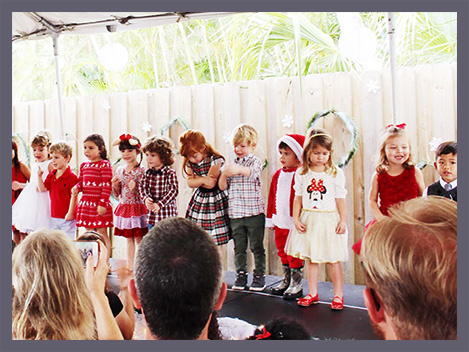Why Choose a Montessori School for Your Child?
OUR PHILOSOPHY
When pediatrician Emmi Pikler opened an institute for orphans 52 years ago in her native Budapest, she faced a dilemma endemic to such institutions: How can a group of infants receive individualized attention with a limited number of caregivers?
“While learning…to turn on the belly, to roll, creep, sit, stand and walk, (the baby) is not only learning those movements but also how to learn. He learns to do something on his own, to be interested, to try out, to experiment. He learns to overcome difficulties. He comes to know the joy and satisfaction which is derived from this success, the result of his patience and persistence.”
In short, Pikler had a revolutionary idea: that babies, even newborns, are competent individuals with their own agendas, and should be treated with respect. The Pikler method gave such a boost to orphaned babies, it stands to reason it would be a great boost to babies raised at home by loving parents.
One of Pikler’s proteges, Hungarian-born Magda Gerber, has transformed Pikler’s work and made it accessible to parents. Her Resources for Infant Educators (RIE) based in Los Angeles, California, offers parents and teachers classes based on the Pikler method.
The basis for putting any of Pikler/Gerber’s ideas into action is a warm, loving relationship between parent, or another primary caretaker, and child. Since babies experience our love during times we spend caring for them, Gerber suggests that parents take the time to make diapering, feeding, bathing, and dressing, unhurried and pleasant quality time with the baby being an active partner. With their built-in “curriculum,” babies, given security and freedom, will then spend their time learning just what they need to be learning at any given stage.
``
When you approach your baby with an attitude of respect, you tell him what you intend to do and give him a chance to respond
``
Gerber further says, “You assume he is competent and involve him in his care and let him, as much as possible, solve his own problems. You give him plenty of physical freedom and you don’t push development.”
She adds, “Parents believe they treat their babies with respect. But if you watch well-meaning, loving adults, you’ll see that they will often interrupt their baby’s play without a thought and treat her in other ways that could hardly be called respectful. ”
What does this all mean for you and your baby? When you want to change a diaper, dress or feed, look first to see what your baby is doing. If your baby is absorbed in an activity and you have the time, try not to interrupt. Look for the right moment to move in. Say something like, “I want to change your diaper now,” and reach out your arms. Wait for a response. Your baby may look up at you or reach out with arms. If your request is ignored, and you have time, you can say something like, “I see you still want to play,” and wait a couple of minutes before trying again. If you don’t have time, you can still acknowledge that baby would rather play but say that you need to change the diaper now and start doing that. Even if your baby is too young to understand your words, your tone will be associated with your gestures.
Once on the changing table, don’t distract the baby with a rattle. Instead, try to maintain eye contact and explain, step-by-step, what you are doing and ask for help: “I’m putting you down on the table. Now I’m going to take off your pants — can you pull your foot out? Thank you.” Or, “I’m going to take off your wet diaper now. Please lift your hips up.”
After years of patient struggle, the RIE approach is now receiving recognition in the United States. The National Association for the Education of Young Children (NAEYC) and Zero to Three, the National Center for Clinical Infant Programs, have recently incorporated basic RIE ideas into their recommendations for infant care.
Gerber’s emphasis on the need to understand and get to know babies as people has been very influential in our writings about infant care and the way people actually care for infants in the U.S.,” says Sue Bredekamp, Director of Professional Development for NAEYC. “We agree with her on the importance of paying attention to a baby’s cues and messages, rather than coming in with our own agendas. For example, Gerber believes that when a baby cries, instead of the adult deciding what’s wrong and responding instantly, she should wait a moment to see what the baby does. Does he self-comfort? Does he find a solution? These are excellent guidelines for parents.” After much discussion, NAEYC will most likely include a surprising recommendation by Gerber in their new guidelines: that babies should not be encouraged to look into mirrors until they are of walking age. “Babies are fascinated with faces,” Bredekamp says. “They see their image in a mirror and reach out to touch the face and instead, touch something that’s cold and hard. Gerber believes that’s confusing.”
Part of the reason that various national guidelines are now reflecting RIE ideas is the fact that “research is catching up with Gerber,” according to Peter Mangione, co-creator of the Program for Infant-Toddler Caregivers, a collaborative project of WestEd/Far West Laboratory and the California Department of Education, Child Development Division.
``
For years, people in the field were pushing face-to-face interaction with infants
``
Mangione further states “Gerber was in favor of slowing this down and giving a baby more space. Over time, people doing the research started to hear her out. They realized that the important thing was giving the child control of the interaction rather than lots of stimulation. Researchers started to notice babies’ self-regulatory activities and to give them more weight.”
The once widely accepted notion that parents should stimulate and teach their babies, a practice that Gerber disputes, has also been called into question by recent research. “Twenty years ago, if you went to a session on infant cognition, you’d see a lot of emphasis on the importance of adults stimulating infants,” Mangione says. “Now, the emphasis is on what infants do and on the partnership between infants and adults. This is something Gerber stressed for years.”
OUR MUSIC PHILOSOPHY
Music classes are based on the recognition that all children are musical. All children can learn to sing in tune, keep a beat, and participate with confidence in the music of our culture, provided that their early environment supports such learning. We believe that music education begins at birth and progresses in the same manner as language. In working with babies we see that they are alert to each new song, they can sense when a song comes to an end, they notice dynamics, they respond to tempo changes. Perhaps most dramatic is they can coo in the tonality of a given song. Babies frequently respond to hearing their caregivers singing a song and shift their own habitual sounding pitch to meet the tone or another tone from the songs main chord in effect synchronizing them to the singer.
All children are musical. This is the cornerstone of our philosophy. Children learn seemingly with no effort along the development path toward basic music competence in much the same way they learn a language, apparently by absorbing it from the environment. Similar to the way a child moves from babble to a single word, and then to two-word sentences, they move from music babble to musical expression of greater complexity. An early milestone is the ability to hear notes in relation to one another, therefore begin to produce two separate pitches.
Soon the child will be singing bits and pieces of songs accurately. Gradually, he would align himself more and more with accurate pitch. Like language, we call the different aspects of musical processing receptive and expressive and basic musical competence arises out of the inner feedback loop that gets established between the two systems.
We provide a musically rich environment that is so vital to music learning from infancy and beyond. Our environment will be rich with singing, movement, dance, and instruments specially designed for babies.
Humans have the capacity to develop remarkable mental storage systems. Establishing systems of memory and learning is an essential childhood task. The brains of children are in a sense doing double duty. At the same time that they are processing many types of information, categorizing them, and storing them into memory, they are busily forming the very neural structure that performs these tasks. Before the child develops the ability to sing in tune and move with accurate rhythm, it is difficult for him to store music memories adequately.

Like talking, music making (singing, dancing, playing an instrument, and clapping) is a basic life skill, fundamental to our human nature and available to all, regardless of so-called talent.
Like talking, music learning requires the modeling of primary caregivers. By actively making music, regardless of their ability, the adults that love and care for children help them acquire the disposition to be music makers, too.
Like talking, the ability to speak the language and acquire a basic level of fluency to be understood, including signing in tune and moving with accurate rhythm, requires music learning through most of the early childhood years, from birth through kindergarten.
Like talking, basic fluency in music is a developmental prerequisite to formal instruction in reading, writing, and performing the language of music.
We are committed to being a community of music makers and provide a musically rich environment where your children will thrive musically.
